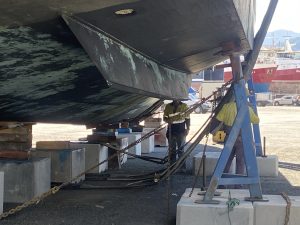July 16, 2021
Docking of boats and ships are routine operations that are underpinned by engineering assessments. The consequences of a marine vessel or persons being damaged because of poorly planned and executed docking operations are significant for all stakeholders.
The risk is typically minimised through provision of a suitable docking plan and the yards internal review and development of tailored docking procedures. The vessel owner relies on the yard engineering process and acceptance to shift the risk to the contracted yard who are appropriately insured.
Sometimes there is no docking plan, and the risk profile changes for all stakeholders. As suggested by (Heger Dry Dock) the risk can be mitigated by:
• Contacting the yard where ship was last dry docked and talking to the dockmaster
• Consulting previous docking reports or docking plans of sister ships; or
• Contacting the shipyard where ship was built.
Initially a vessel owner/operator will send the particulars of a vessel to a dock with a view to gaining a quote. The vessel docking plan is sent, the yard reviews the plan and tailors a docking procedure to suit. The docking price offered is based on the disposition of the vessel (geometry, weight, loading and tanks) and the generation of a robust docking procedure. The docking procedure draws heavily on standard dock operating structures and the engineering component undertaken by a competent engineer is generally insignificant. Often the vessel owner, yard and engineer are intimately familiar with the vessel and unique requirements as part of an ongoing relationship.
Therefore, to mitigate docking risks the vessel docking plan and the yard process must be robust and completed with due consideration to the uniqueness of vessel, disposition and available capacity or infrastructure and equipment.
Vessel docking plans are generally developed by the original designer or Naval Architect. The associated drawing is unique to the vessel and includes engineering consideration of the vessel strength and service requirements as anticipated by the Naval Architect. This is no easy task when the docking plan needs to adequately cover slipway, drydock, travel-lift and synchro-lift docking operations. Like stability booklets, vessel docking plans are not always passed between new owners and are often overlooked in the plan’s drawer. They do not always reflect the actual state of the vessel due to historical repairs and modifications.

Some examples of docking plans on the web include:
https://www.c-ladybugauction.eu/sites/c-ladybugauction.eu/files/plan/plan_c-ladybug.pdf
https://3dym.com/Assets/DockPlan.htm
As can be seen the quality and extent of content is skewed towards the purpose of the docking plan and type of docking and available docking infrastructure expected.
In the case of damaged vessels, the docking plan should be amended prior to docking to include damaged areas and considerations as verified with underwater inspection activities.
A docking plan should be a drawing showing plan and elevation and may include:
• Relevant Reference Drawings
• Draft Mark Locations and Painting Requirements
• Overall Dimensions and Datums
• Air Gap Requirements, Articulation of Antennas
• Propeller, Stabiliser Appendage Tip Locations
• Keel Profile
• Acceptable Blocking and Shoring Positions and Offsets
• Acceptable Sling Positions and Offsets
• Vessel Load and Tank Disposition Basis – Load Case
• Location of Fwd and Aft Perpendiculars
• Frame and bulkhead spacing
• Anticipated Block Pressures and Hull Capacity.
• Clearance required for shaft removal
• Clearance required for rudder removal
• List of hull protrusions and openings
The Docking Plan may also include cross section to show areas of specific consideration. A simple google search would identify numerous resources and examples of docking plans.
It is not the intent of this article to expand on the requirements side of the shipyard however like the docking the plan, the process is an engineered marine operation and should be treated accordingly.


